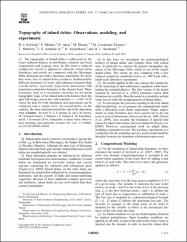Topography of inland deltas: Observations, modeling, and experiments
Tarih
2010-04-28Yazar
Seybold, Hansjörg J.Molnar, Peter
Akça, Mehmet Devrim
Doumi, M.
Tavares, M. Cavalcanti
Shinbrot, Troy
Andrade, Jose Soares
Kinzelbach, Wolfgang
Herrmann, Hans Jürgen
Üst veri
Tüm öğe kaydını gösterKünye
Seybold, H., Molnar, P., Akça, M. D., Doumi, M., Tavares, M., Shinbrot, T., . . . Herrmann, H. (2010). Topography of inland deltas: Observations, modeling, and experiments. Geophysical Research Letters, 37(8), 1-5. doi:10.1029/2009GL041605Özet
The topography of inland deltas is influenced by the water-sediment balance in distributary channels and local evaporation and seepage rates. In this letter a reduced complexity model is applied to simulate inland delta formation, and results are compared with the Okavango Delta, Botswana and with a laboratory experiment. We show that water loss in inland deltas produces fundamentally different dynamics of water and sediment transport than coastal deltas, especially deposition associated with expansion-contraction dynamics at the channel head. These dynamics lead to a systematic decrease in the mean topographic slope of the inland delta with distance from the apex following a power law with exponent alpha = -0.69 +/- 0.02 where the data for both simulation and experiment can be collapsed onto a single curve. In coastal deltas, on the contrary, the slope increases toward the end of the deposition zone.


















